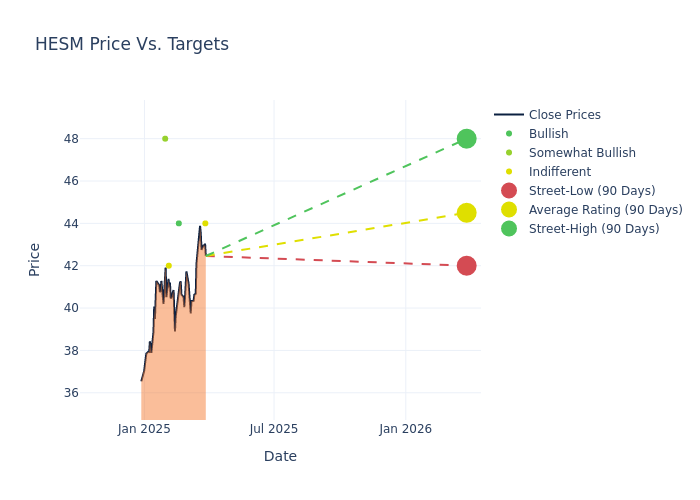
Hess Midstream (NYSE:HESM) has been analyzed by 5 analysts in the last three months, revealing a diverse range of perspectives from bullish to bearish.
The following table provides a quick overview of their recent ratings, highlighting the changing sentiments over the past 30 days and comparing them to the preceding months.
| Bullish | Somewhat Bullish | Indifferent | Somewhat Bearish | Bearish | |
|---|---|---|---|---|---|
| Total Ratings | 1 | 2 | 2 | 0 | 0 |
| Last 30D | 0 | 0 | 1 | 0 | 0 |
| 1M Ago | 0 | 0 | 0 | 0 | 0 |
| 2M Ago | 1 | 2 | 1 | 0 | 0 |
| 3M Ago | 0 | 0 | 0 | 0 | 0 |
In the assessment of 12-month price targets, analysts unveil insights for Hess Midstream, presenting an average target of $44.6, a high estimate of $48.00, and a low estimate of $42.00. Surpassing the previous average price target of $41.40, the current average has increased by 7.73%.

Investigating Analyst Ratings: An Elaborate Study
The standing of Hess Midstream among financial experts becomes clear with a thorough analysis of recent analyst actions. The summary below outlines key analysts, their recent evaluations, and adjustments to ratings and price targets.
| Analyst | Analyst Firm | Action Taken | Rating | Current Price Target | Prior Price Target |
|---|---|---|---|---|---|
| Jeremy Tonet | JP Morgan | Raises | Neutral | $44.00 | $39.00 |
| Spiro Dounis | Citigroup | Raises | Buy | $44.00 | $41.00 |
| Praneeth Satish | Wells Fargo | Raises | Equal-Weight | $42.00 | $40.00 |
| JR Weston | Raymond James | Raises | Outperform | $48.00 | $45.00 |
| JR Weston | Raymond James | Raises | Outperform | $45.00 | $42.00 |
Key Insights:
- Action Taken: In response to dynamic market conditions and company performance, analysts update their recommendations. Whether they 'Maintain', 'Raise', or 'Lower' their stance, it signifies their reaction to recent developments related to Hess Midstream. This insight gives a snapshot of analysts' perspectives on the current state of the company.
- Rating: Unveiling insights, analysts deliver qualitative insights into stock performance, from 'Outperform' to 'Underperform'. These ratings convey expectations for the relative performance of Hess Midstream compared to the broader market.
- Price Targets: Analysts set price targets as an estimate of a stock's future value. Comparing the current and prior price targets provides insight into how analysts' expectations have changed over time. This information can be valuable for investors seeking to understand consensus views on the stock's potential future performance.
Understanding these analyst evaluations alongside key financial indicators can offer valuable insights into Hess Midstream's market standing. Stay informed and make well-considered decisions with our Ratings Table.
Stay up to date on Hess Midstream analyst ratings.
Discovering Hess Midstream: A Closer Look
Hess Midstream LP owns, operates, develops, and acquires a diverse set of midstream assets and provides fee-based services to Hess and third-party customers. It conducts its business through three operating segments: gathering, processing and storage, and terminaling and exporting. The company derives the maximum revenue from the gathering segment. Its gathering segment consists of the following assets namely Natural Gas Gathering and Compression; Crude Oil Gathering and Produced Water Gathering and Disposal.
Hess Midstream's Financial Performance
Market Capitalization Analysis: Below industry benchmarks, the company's market capitalization reflects a smaller scale relative to peers. This could be attributed to factors such as growth expectations or operational capacity.
Positive Revenue Trend: Examining Hess Midstream's financials over 3 months reveals a positive narrative. The company achieved a noteworthy revenue growth rate of 11.02% as of 31 December, 2024, showcasing a substantial increase in top-line earnings. As compared to competitors, the company surpassed expectations with a growth rate higher than the average among peers in the Energy sector.
Net Margin: Hess Midstream's financial strength is reflected in its exceptional net margin, which exceeds industry averages. With a remarkable net margin of 17.82%, the company showcases strong profitability and effective cost management.
Return on Equity (ROE): The company's ROE is a standout performer, exceeding industry averages. With an impressive ROE of 13.26%, the company showcases effective utilization of equity capital.
Return on Assets (ROA): Hess Midstream's ROA excels beyond industry benchmarks, reaching 1.7%. This signifies efficient management of assets and strong financial health.
Debt Management: Hess Midstream's debt-to-equity ratio is notably higher than the industry average. With a ratio of 6.54, the company relies more heavily on borrowed funds, indicating a higher level of financial risk.
The Core of Analyst Ratings: What Every Investor Should Know
Benzinga tracks 150 analyst firms and reports on their stock expectations. Analysts typically arrive at their conclusions by predicting how much money a company will make in the future, usually the upcoming five years, and how risky or predictable that company's revenue streams are.
Analysts attend company conference calls and meetings, research company financial statements, and communicate with insiders to publish their ratings on stocks. Analysts typically rate each stock once per quarter or whenever the company has a major update.
Some analysts also offer predictions for helpful metrics such as earnings, revenue, and growth estimates to provide further guidance as to what to do with certain tickers. It is important to keep in mind that while stock and sector analysts are specialists, they are also human and can only forecast their beliefs to traders.
Which Stocks Are Analysts Recommending Now?
Benzinga Edge gives you instant access to all major analyst upgrades, downgrades, and price targets. Sort by accuracy, upside potential, and more. Click here to stay ahead of the market.
This article was generated by Benzinga's automated content engine and reviewed by an editor.